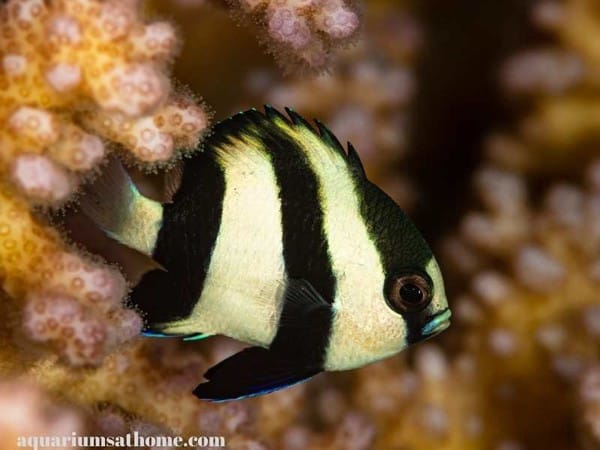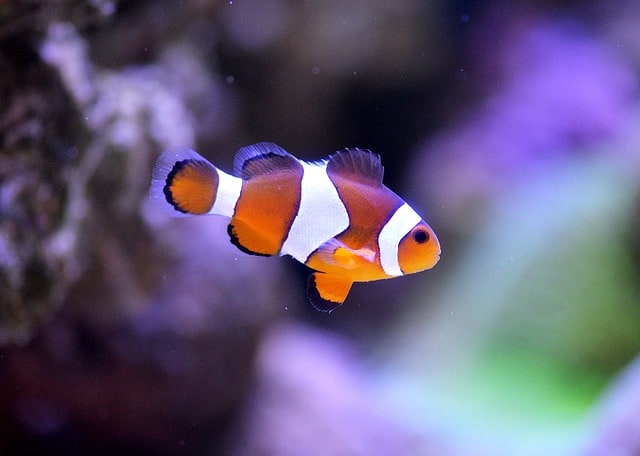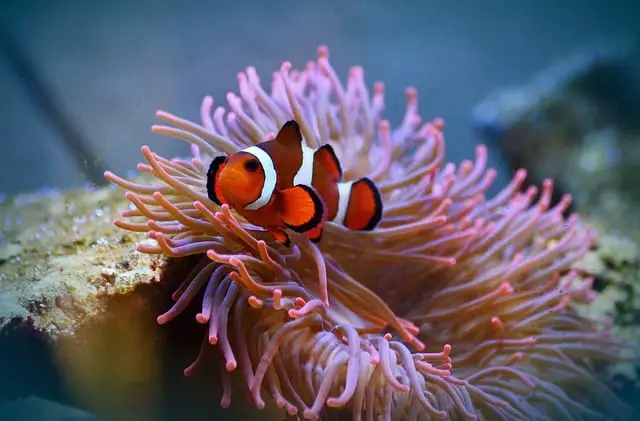Damselfish are a type of saltwater fish that are relatively small with vibrant coloring. Bright shades of blue, red, and yellow add interest and ‘life’ to any marine aquarium. But don’t let their small size fool you! This little fish can hold its own in a community tank which begs the question, ‘why are damselfish so aggressive?’
Damselfish are highly protective of their offspring and will become extra aggressive around breeding time. They often stand guard over their eggs and with their strong bite force can inflict significant harm on any creature they deem as a threat. Relentless in their pursuit, they won’t stop until their target submits or dies.
Now that you know most damselfish tend to be aggressive in nature, let’s explore this topic further. Together we’ll discover why this species is so hostile, how to lessen their aggression and whether (or not) they can kill other aquarium fish. We’ll also discuss which species is the most aggressive and which is the least.
So, if you’re ready to dive deeper into the aquatic world of the damselfish and learn more about the social habits of this species in captivity, then let’s begin!
Why are Damselfish Aggressive?
Damselfish are highly territorial. This is what leads to their heightened aggression, especially in captivity where space is limited. Protecting their home and their offspring by any (and all) means necessary is an inherent trait with this species. In fact, they can be so vicious that they’ll target subordinate tankmates, chase them until they submit and then batter them to death!
What is the Most Aggressive Damselfish?
Most damselfish possess some level of aggression but the most hostile is the blue damsel. This species is extremely territorial and will chase and nip at any creature that invades its aquatic space. Armed with strong teeth and an intense bite force, blue devil damsels can seriously injure (and even kill) other fish in a community tank environment.
Are Blue Damsels Aggressive?
As mentioned above, blue devil damsels are extremely aggressive. They’ll even bite the hand that feeds if you happen to place it in the tank!
Very fast and highly territorial, this species is difficult to catch should you intend to remove it or place it in quarantine. Once this fish has been acclimated to a tank and then established its territory, you can’t introduce any smaller fish as they’ll likely be harassed to death.
Are Domino Damsels Aggressive?
Like blue devils, 3-spot domino damsels are also aggressive and become more so with age. They’re best kept in a species-only tank or with larger fish. As dominos can reach adult lengths of up to 6 inches, they need a larger tank (55-gallons minimum) to provide them with the space and security they need. When overcrowded in too small of a tank, their hostility level increases ten-fold!
Are Neon Velvet Damselfish Aggressive?
This species of damselfish starts out black with blue stripes and then changes to a deep, velvety shade of ebony. Like their domino cousins, they become more territorial and aggressive when they reach sexual maturity. Their considerable size allows to inflict significant harm on subordinate tankmates. Therefore, they require a very large species-only tank, or you can keep a single adult with bigger, peaceful fish.

Are Sergeant Major Damselfish Aggressive?
This damselfish gets its name from the bold blue stripes across its body that are reminiscent of a military leader’s badge. And in an aquarium setting, they’re just as bold, even when young. Like other damsels, they become increasingly hostile with age. Reaching adult lengths of up to 8 inches, they require an extra-large species-only tank, or you can keep them with other fearless fish like angelfish and triggerfish.
Are Striped Damselfish Aggressive?
The two, three, and four stripe damsels are smaller in size but equally mean in comparison to their larger, domino cousins. As a result, they can’t share a tank with tiny, docile fish as they’ll likely be bullied to death. To lessen striped damselfish aggression, they should be kept in a 30-gallon tank with others of their species.
What is the Most Peaceful Damselfish?
The least hostile species of damselfish include the azure and the Talbot’s damsel. These two tend to be more docile than their highly aggressive blue devil and domino damsel cousins. Other damsels like the yellowtail and the Rolland’s are considered semi-aggressive in nature. Essentially, there’s really no such thing as a ‘peaceful’ damsel but rather varying levels of mild, moderate, and extreme aggression.
Chromis fish – which are a sub-species of damselfish – also tend to be more docile in nature. The blue reef, blue, green, and blue-green chromis’ are all great for community tank environments, provided they’re not overcrowded and their tankmates are of like size and temperament. A reef set-up with plenty of coral and some planted areas with algae to graze on will keep these fish calm and content.
Do Damsels Kill Other Fish?
Damselfish will kill other fish they deem as either weak or a threat. Typically, they’ll chase their target until exhausted and then bite or batter them into submission. The often won’t rest until the victim is near death. For this reason, it’s best to keep damsels in small groups in a species-only tank. The bigger the aquarium, the better so that each fish has plenty of space to claim its own territory.
Does Tank Size Affect Damselfish Aggression?
The size of the tank has a direct effect on damselfish aggression. If the aquarium is overpopulated, the fish will feel stressed and start taking it out on their tankmates. Since this species is known for being highly territorial, they need plenty of room so as not to invade each other’s space. A 30-gallon is the minimum I’d recommend for 3 to 4 damsels – 1 male with 2 or 3 females or all females is preferable.
If you want to have more saltwater fish in the same tank, the size of the aquarium should increase drastically. With 2 or 3 damsels and 2 or 3 other marine fish, I’d recommend at least a 55-gallon but if you can afford an even larger one, then please do that.
You’ll find that with a larger tank all fish will be able to claim their own space without infringing on each other too much. This will make for a much safer tank for all inhabitants.
What Fish Help Lessen Damsel Aggression?
Fish of the same species help lessen damsel aggression. Mixing different types of damsels in the same tank usually isn’t recommended unless they’re put in the aquarium while still young and then grow up together.
Larger fish that can hold their own will also keep damsel hostility at bay as they tend to single out the weaker fish. As well, don’t introduce smaller fish to the tank once damsels have been established.
How to Make Damselfish Less Aggressive?
To make damselfish less aggressive you should keep them in a large tank with lots of hiding places for cover. The extra space will allow each fish to claim its own territory, so they don’t become hostile and start attacking each other. Adding live rock to the tank will also help to provide shelter and safety.
Are Damselfish Good for Beginner Hobbyists?
Damselfish are very easy to maintain when kept in the proper aquatic environment. All they need to survive is a saltwater tank with the correct water parameters and a few decorations for cover. Since they’re omnivores, they’ll east just about anything given to them including live and frozen meaty foods as well as planted-based flakes and pellets.
Conclusion
To conclude, damselfish by nature are inherently aggressive. While some species are less hostile than others, most damsels are territorial and don’t take well to other fish invading their space. An extra-large, species-only tank with lots of hiding places will help curb their aggression. Mixing different types of damselfish in the same aquarium is usually not recommended and will likely add to their hostility.
I hope this article has answered your questions pertaining to damselfish aggression in captivity. Thanks for reading and good luck with your aquarium hobby.
Related Posts
Are Blue Tangs Difficult to Keep?
Can You Keep a Lionfish in a Reef Tank?
What Fish Go Well with Damsels?
How Do You Catch a Damselfish? (From a Fish Tank)




